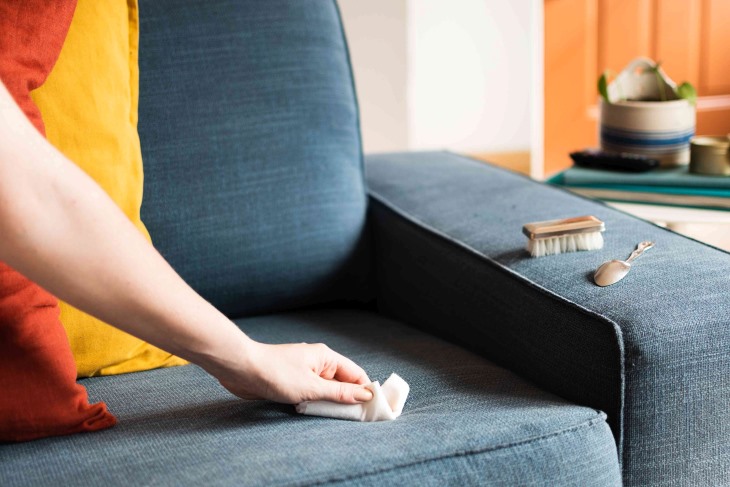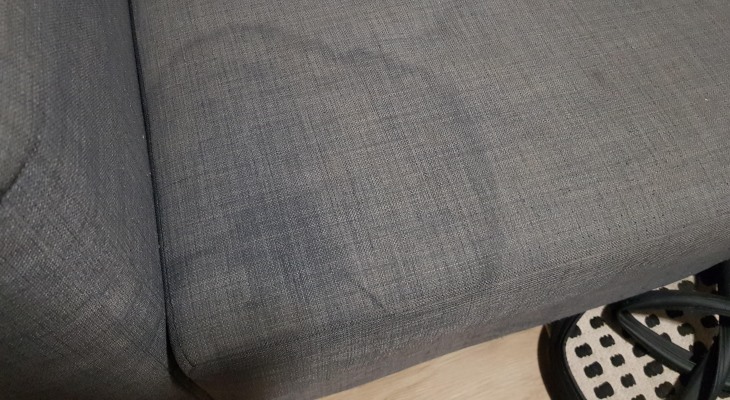While water is usually used when attempting to remove stains, it may surprise you to learn that water itself can actually cause a stain! If this has happened to you, you may wonder how to remove water stains from a fabric sofa.
Most water stains can be removed by using a combination of mild detergent, vinegar, and some patience. There are no fancy tricks needed here. Just a few products that you already have around your house.
Table of Contents
How Can Water Make a Stain?

In most cases, it’s not the water itself that makes the stain but any minerals or extra particles that are mixed in with the water. They usually appear as a “ring”, with the stain being on the outer edges and the middle of the ring appearing clean.
Water from municipalities is usually treated with harmless minerals to make it safe for consumption. Unfortunately, these minerals don’t react well with some fabrics, thus causing your basic tap water to leave a stain on your couch fabric.
Before You Begin
Make sure you know what type of fabric is on your couch.
Most commercial couch fabric can be cleaned with mild detergent. Antique pieces with a vintage cloth or couch cushions made of real leather may need a professional to restore them.
How to Clean a Water Stain on Couch Fabric
If it’s possible to remove the outer cushion cover, it is recommended you do so. This is just to make it easier on you to clean. If you can’t remove it or are unsure and don’t want to cause further damage, that is ok. This method will work just as well.
Tip: Even though this method works wonderfully on removing water stains, it is also helpful at removing other minor stains too!
Blot the Area Dry
If it is a fresh stain and is still slightly damp, gently blot the area with a clean rag or a paper towel. You want to remove as much of the stain-producing water as you can.
Take care not to rub vigorously or press down too hard. You don’t want to push the water deeper into the fabric. Just a couple of gentle pats should do the trick.
Choose Your Cleaning Solution

You have two great options when it comes to choosing your solution: mild dish soap or vinegar.
The safest option is distilled vinegar, as it is less likely to leave any residue. It can be mixed either in a bowl or a spray bottle.
Mild dish soap is also possible to use, but it does have the potential to stain certain fabrics, especially if there is dye in the soap. Only use dish soap if you’re positive your fabric can handle it.
You can also alternate between the two: using the vinegar solution first and removing the difficult spots with dish soap.
Tip: Do a spot test on an unexposed portion of the couch fabric – preferably the seam. Simply rub the solution into a dime-sized area and wait for 20 minutes to see if the fabric discolors in any way.
Mix Your Solution with Distilled Water
This is a very important step! Try not to mix the vinegar or dish soap with tap water, as it will reduce the effectiveness of the solution, especially if your stain was caused by tap water in the first place.
Use a bottle of water from your fridge and mix in equal parts with your desired cleaning solution. If you don’t have any bottled water, check out the end of the article for how to easily make your own distilled water!
If you do use tap water, keep it mind it may not be as effective.
Blot The Stain
Dip your rag into your cleaning solution, just enough to get a small amount. You don’t want it soaking wet. Very gently, blot only the stain. Avoid rubbing back and forth so you don’t spread the particulates around and create new stains.
Repeat until the entire stain is covered with the cleaning solution. Grab a new, clean cloth and repeat the process as many times as necessary until you feel you have thoroughly removed the entire stain.
Let It Rest
Allow the solution to rest and soak in slightly to the fabric to ensure it penetrates all stained fibers. This should only take about 10-15 minutes.
While it is sitting, check it periodically for any spots that are drying. Remoisten these areas with more of your cleaning solution.
Blot Again With water Only
Wet another clean cloth with your distilled water only and blot the entire stain again to remove as much residual cleaning solution as you can.
This will help prevent any strong smells (especially important if you used vinegar) and should remove the last bits of the staining particles.
Dry Immediately

It is not recommended that you leave the spot to air dry, as you may be left with a new stain. If you have removed the couch cushion cover, you can throw it in your dryer on low heat.
You can also use a hair dryer on the “cool” setting, just be sure to hold it at least 2 feet away from the fabric to avoid heat distress. You should never use the “heat” setting as this could cause irreparable damage to the couch fibers.
Repeat As Needed
By now, your stain should look much more faded or be completely gone! If you notice a few spots left that you may have missed or were more heavily stained, you can repeat the above steps as many times as you need until your cushion looks good as new.
Final Thoughts
Stains are a normal part of life, and even something as simple as water can leave an unsightly ringed stain on your couch cushions. But removing them doesn’t have to be a hassle.
By carefully following the proper cleaning steps, your couch cushions will look beautiful again, sometimes in as little as 30 minutes! Additionally, you’d save a lot of money on maids or professional cleaning services if this is a recurring issue.
BONUS: DIY Distilled Water
Distilled water is simply the collection of condensation from boiled water. It helps to remove impurities and bacteria without the need for added minerals. Not only is it easy to make, but can be a fun science experiment for kids to learn about the distillation process. You will need:
- A large stainless steel pot with a lid
- A pot rack or a kitchen towel
- A heat resistant glass bowl
- Ice
Step 1: Fill the pot about halfway full with tap water and place either the pot rack or a folded up kitchen towel on the bottom. Place your glass bowl inside the pot on top of the rack or towel. It should “float” on top of the water and not touch the bottom of the pan. If the water level is too high, pour some out. It should not go more than halfway up the bowl.
Step 2: Place the lid on upside down (handle side down) so it forms a little bowl on top of the pot. Fill the inverted lid up with ice.
Step 3: Turn the burner on high and wait for the water to boil. As the water boils, the steam will condense on the cold ice-filled lid. This will then drip down into the glass bowl – that is the distilled water! Be sure to refill the ice as it begins to melt and scoop out any melted ice as needed. You want the lid to stay as cold as possible.
Step 4: After 45 minutes, turn the burner off, and remove the lid and the glass bowl – use oven mitts for this, the bowl will be very hot! Allow the water to cool completely and store in a clean container.

